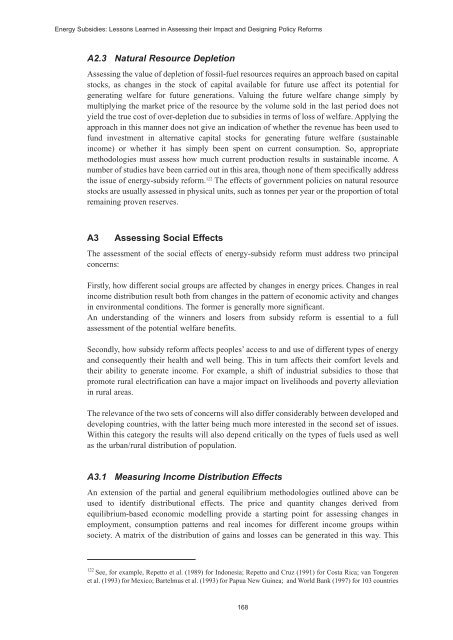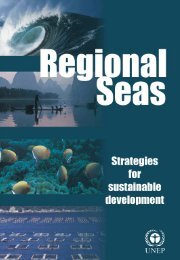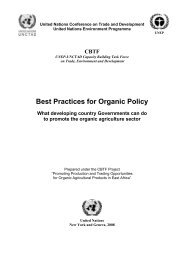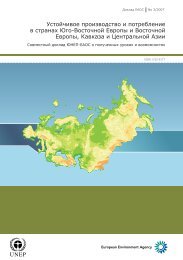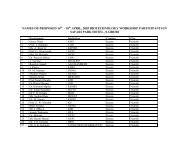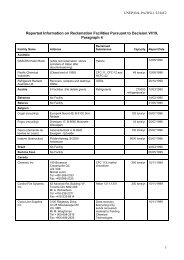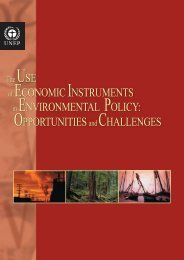Energy Subsidies: Lessons Learned in Assessing their Impact - UNEP
Energy Subsidies: Lessons Learned in Assessing their Impact - UNEP
Energy Subsidies: Lessons Learned in Assessing their Impact - UNEP
You also want an ePaper? Increase the reach of your titles
YUMPU automatically turns print PDFs into web optimized ePapers that Google loves.
<strong>Energy</strong> <strong>Subsidies</strong>: <strong>Lessons</strong> <strong>Learned</strong> <strong>in</strong> Assess<strong>in</strong>g <strong>their</strong> <strong>Impact</strong> and Design<strong>in</strong>g Policy Reforms<br />
A2.3 Natural Resource Depletion<br />
Assess<strong>in</strong>g the value of depletion of fossil-fuel resources requires an approach based on capital<br />
stocks, as changes <strong>in</strong> the stock of capital available for future use affect its potential for<br />
generat<strong>in</strong>g welfare for future generations. Valu<strong>in</strong>g the future welfare change simply by<br />
multiply<strong>in</strong>g the market price of the resource by the volume sold <strong>in</strong> the last period does not<br />
yield the true cost of over-depletion due to subsidies <strong>in</strong> terms of loss of welfare. Apply<strong>in</strong>g the<br />
approach <strong>in</strong> this manner does not give an <strong>in</strong>dication of whether the revenue has been used to<br />
fund <strong>in</strong>vestment <strong>in</strong> alternative capital stocks for generat<strong>in</strong>g future welfare (susta<strong>in</strong>able<br />
<strong>in</strong>come) or whether it has simply been spent on current consumption. So, appropriate<br />
methodologies must assess how much current production results <strong>in</strong> susta<strong>in</strong>able <strong>in</strong>come. A<br />
number of studies have been carried out <strong>in</strong> this area, though none of them specifically address<br />
the issue of energy-subsidy reform. 122 The effects of government policies on natural resource<br />
stocks are usually assessed <strong>in</strong> physical units, such as tonnes per year or the proportion of total<br />
rema<strong>in</strong><strong>in</strong>g proven reserves.<br />
A3<br />
Assess<strong>in</strong>g Social Effects<br />
The assessment of the social effects of energy-subsidy reform must address two pr<strong>in</strong>cipal<br />
concerns:<br />
Firstly, how different social groups are affected by changes <strong>in</strong> energy prices. Changes <strong>in</strong> real<br />
<strong>in</strong>come distribution result both from changes <strong>in</strong> the pattern of economic activity and changes<br />
<strong>in</strong> environmental conditions. The former is generally more significant.<br />
An understand<strong>in</strong>g of the w<strong>in</strong>ners and losers from subsidy reform is essential to a full<br />
assessment of the potential welfare benefits.<br />
Secondly, how subsidy reform affects peoples’ access to and use of different types of energy<br />
and consequently <strong>their</strong> health and well be<strong>in</strong>g. This <strong>in</strong> turn affects <strong>their</strong> comfort levels and<br />
<strong>their</strong> ability to generate <strong>in</strong>come. For example, a shift of <strong>in</strong>dustrial subsidies to those that<br />
promote rural electrification can have a major impact on livelihoods and poverty alleviation<br />
<strong>in</strong> rural areas.<br />
The relevance of the two sets of concerns will also differ considerably between developed and<br />
develop<strong>in</strong>g countries, with the latter be<strong>in</strong>g much more <strong>in</strong>terested <strong>in</strong> the second set of issues.<br />
With<strong>in</strong> this category the results will also depend critically on the types of fuels used as well<br />
as the urban/rural distribution of population.<br />
A3.1 Measur<strong>in</strong>g Income Distribution Effects<br />
An extension of the partial and general equilibrium methodologies outl<strong>in</strong>ed above can be<br />
used to identify distributional effects. The price and quantity changes derived from<br />
equilibrium-based economic modell<strong>in</strong>g provide a start<strong>in</strong>g po<strong>in</strong>t for assess<strong>in</strong>g changes <strong>in</strong><br />
employment, consumption patterns and real <strong>in</strong>comes for different <strong>in</strong>come groups with<strong>in</strong><br />
society. A matrix of the distribution of ga<strong>in</strong>s and losses can be generated <strong>in</strong> this way. This<br />
122<br />
See, for example, Repetto et al. (1989) for Indonesia; Repetto and Cruz (1991) for Costa Rica; van Tongeren<br />
et al. (1993) for Mexico; Bartelmus et al. (1993) for Papua New Gu<strong>in</strong>ea; and World Bank (1997) for 103 countries<br />
168


